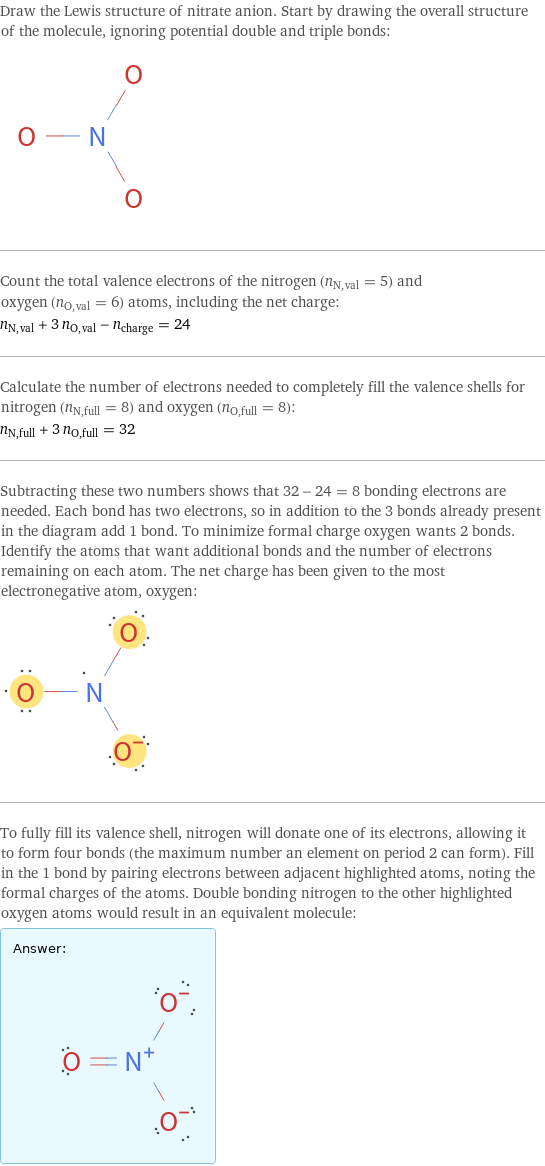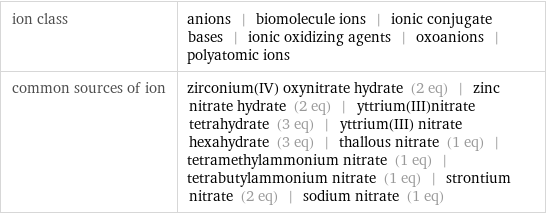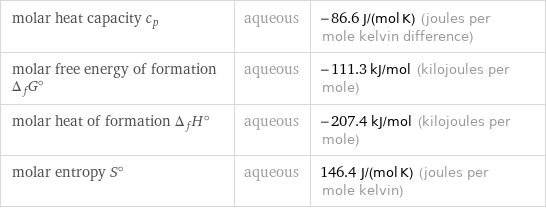Input interpretation

nitrate anion
Lewis structure

Draw the Lewis structure of nitrate anion. Start by drawing the overall structure of the molecule, ignoring potential double and triple bonds: Count the total valence electrons of the nitrogen (n_N, val = 5) and oxygen (n_O, val = 6) atoms, including the net charge: n_N, val + 3 n_O, val - n_charge = 24 Calculate the number of electrons needed to completely fill the valence shells for nitrogen (n_N, full = 8) and oxygen (n_O, full = 8): n_N, full + 3 n_O, full = 32 Subtracting these two numbers shows that 32 - 24 = 8 bonding electrons are needed. Each bond has two electrons, so in addition to the 3 bonds already present in the diagram add 1 bond. To minimize formal charge oxygen wants 2 bonds. Identify the atoms that want additional bonds and the number of electrons remaining on each atom. The net charge has been given to the most electronegative atom, oxygen: To fully fill its valence shell, nitrogen will donate one of its electrons, allowing it to form four bonds (the maximum number an element on period 2 can form). Fill in the 1 bond by pairing electrons between adjacent highlighted atoms, noting the formal charges of the atoms. Double bonding nitrogen to the other highlighted oxygen atoms would result in an equivalent molecule: Answer: | |
General properties

formula | (NO_3)^- net ionic charge | -1 alternate names | trioxonitrate | trioxidonitrate | nitrate | nitrate(1-)
Ionic radius

thermochemical radius | 179 pm
Units

Other properties

ion class | anions | biomolecule ions | ionic conjugate bases | ionic oxidizing agents | oxoanions | polyatomic ions common sources of ion | zirconium(IV) oxynitrate hydrate (2 eq) | zinc nitrate hydrate (2 eq) | yttrium(III)nitrate tetrahydrate (3 eq) | yttrium(III) nitrate hexahydrate (3 eq) | thallous nitrate (1 eq) | tetramethylammonium nitrate (1 eq) | tetrabutylammonium nitrate (1 eq) | strontium nitrate (2 eq) | sodium nitrate (1 eq)
Thermodynamic properties

molar heat capacity c_p | aqueous | -86.6 J/(mol K) (joules per mole kelvin difference) molar free energy of formation Δ_fG° | aqueous | -111.3 kJ/mol (kilojoules per mole) molar heat of formation Δ_fH° | aqueous | -207.4 kJ/mol (kilojoules per mole) molar entropy S° | aqueous | 146.4 J/(mol K) (joules per mole kelvin)